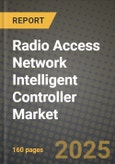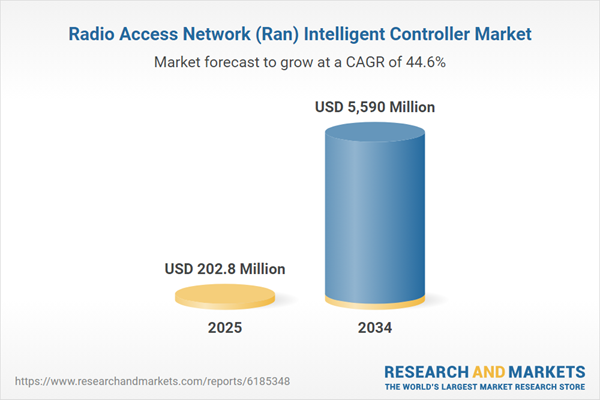Market Overview
The Radio Access Network (RAN) Intelligent Controller market plays a crucial role in the transformation of mobile networks, specifically in the context of 5G and beyond. RAN Intelligent Controllers (RICs) are a key component in the evolution of network architecture, enabling more flexible, programmable, and efficient management of RAN resources. By utilizing technologies such as artificial intelligence (AI), machine learning (ML), and automation, RICs help optimize the performance of network resources and ensure better coverage, capacity, and quality of service. This is particularly important as mobile networks shift from traditional, hardware-based configurations to more software-driven, cloud-native solutions. The increasing demand for high-speed internet, low latency, and connectivity is pushing the adoption of 5G, which in turn, drives the need for more intelligent RAN management systems. The market for RICs is growing rapidly as telecom operators look to implement network functions virtualization (NFV) and software-defined networking (SDN) to reduce operational costs and improve scalability. Despite the promising growth, challenges such as the complexity of integration, the need for standardized protocols, and the high initial investment in RAN infrastructure remain barriers to widespread adoption in some regions and markets.The RAN Intelligent Controller market experienced significant progress, with telecom operators and network vendors deploying more advanced, AI-driven RAN controllers. The rollout of 5G networks provided a substantial boost to the market, as RICs became crucial in managing and optimizing the new 5G infrastructure. Telecom giants such as Ericsson, Nokia, and Huawei, alongside emerging startups, were actively working on developing intelligent controllers capable of managing both 4G and 5G networks simultaneously, ensuring smooth transition and integration between different technologies. The integration of AI and ML algorithms allowed for more dynamic network management, with features such as automated traffic routing, real-time resource allocation, and predictive maintenance becoming common. In addition, the introduction of open RAN standards contributed to the growth of the market by enabling multi-vendor interoperability and reducing the reliance on proprietary systems. However, challenges persisted, such as the high complexity of integrating intelligent controllers into existing infrastructure, and the need for operator buy-in on the adoption of new technologies, particularly in regions where legacy systems were prevalent. Despite these hurdles, the market was poised for continued growth with increasing investments from operators and network equipment providers.
The RAN Intelligent Controller market is expected to see significant advancements, driven by the ongoing deployment of 5G and the anticipation of 6G networks. The market will benefit from further innovations in AI, ML, and cloud technologies, enabling more autonomous, self-optimizing networks. As operators move towards fully virtualized, software-defined networks, RICs will become essential in managing network functions and resources more efficiently, reducing costs, and enhancing the quality of user experience. Additionally, the rise of edge computing will complement RAN controllers, allowing for faster decision-making and better management of network traffic closer to the end-user. With increased investments from telecom operators and partnerships with cloud providers, RICs will be further integrated into network infrastructures. As more industries such as automotive, healthcare, and IoT require more robust connectivity, the demand for intelligent, flexible, and scalable RAN management solutions will continue to grow. However, challenges around standardization, security, and the need for highly skilled personnel to manage these complex systems will need to be addressed to ensure the smooth implementation of RAN Intelligent Controllers in the coming years.
Key Insights: Radio Access Network (Ran) Intelligent Controller Market
- Growing adoption of AI and machine learning in RAN Intelligent Controllers to optimize network performance, improve quality of service, and enable predictive maintenance.
- Increased focus on open RAN standards, driving multi-vendor interoperability and reducing reliance on proprietary systems, fostering a more diverse ecosystem.
- Transition towards cloud-native and software-defined networking (SDN) models, enabling telecom operators to scale and manage their networks more efficiently.
- Rise of edge computing, complementing RAN Intelligent Controllers for faster, localized data processing and more responsive network management.
- Accelerated rollout of 5G and anticipation of 6G networks, pushing for more intelligent and flexible network management solutions to handle the growing demand for connectivity.
- Increasing demand for high-speed internet, low latency, and enhanced mobile connectivity, especially with the adoption of 5G networks, fueling the need for advanced RAN management solutions.
- Advancements in AI, ML, and automation technologies, enabling smarter, more efficient network management and optimization in real-time.
- Telecom operators' need for cost-effective solutions and operational efficiencies through network function virtualization (NFV) and software-defined networking (SDN).
- The rise of open RAN standards, driving competition, cost reduction, and greater flexibility in the RAN ecosystem, allowing multi-vendor deployments and reduced vendor lock-in.
- High integration complexity, lack of standardization, and the initial capital investment required for the deployment of RAN Intelligent Controllers pose challenges to widespread adoption, particularly in regions with legacy network infrastructure.
Radio Access Network (Ran) Intelligent Controller Market Segmentation
By Component
- Platform
- Services
By Technology
- 4G
- 5G
By Function
- Non-Real-Time-RAN Intelligent Controller (Non-RT RIC)
- Near-Real-Time-RAN Intelligent Controller (Near-RT RIC)
By Application
- rApps
- xApps
Key Companies Analysed
- Samsung Electronics Co Ltd
- Huawei Technologies Co Ltd
- Cisco Systems Inc
- Intel Corporation
- Qualcomm Technologies Inc
- Ericsson
- Nokia Corporation
- NEC Corporation
- ZTE Corporation
- Vmware Inc
- CommScope Holding Company Inc
- Juniper Networks Inc
- Ciena Corporation
- Mavenir Systems Inc
- VIAVI SOLUTIONS INC.
- Xilinx Inc
- STERLITE TECHNOLOGIES (STL)
- Radisys Corporation
- Parallel Wireless Inc
- Airspan Networks Inc
- Baicells Technologies Co Ltd
- Pivotal Commware Inc
- ACCELLERAN
- Blue Danube Systems Inc
- Siradel
- Redline Communications Inc
- ASOCS Ltd
- Quortus Ltd
- Lemko Corporation
- Amarisoft
Radio Access Network (Ran) Intelligent Controller Market Analytics
The report employs rigorous tools, including Porter’s Five Forces, value chain mapping, and scenario-based modeling, to assess supply-demand dynamics. Cross-sector influences from parent, derived, and substitute markets are evaluated to identify risks and opportunities. Trade and pricing analytics provide an up-to-date view of international flows, including leading exporters, importers, and regional price trends.
Macroeconomic indicators, policy frameworks such as carbon pricing and energy security strategies, and evolving consumer behavior are considered in forecasting scenarios. Recent deal flows, partnerships, and technology innovations are incorporated to assess their impact on future market performance.Radio Access Network (Ran) Intelligent Controller Market Competitive Intelligence
The competitive landscape is mapped through proprietary frameworks, profiling leading companies with details on business models, product portfolios, financial performance, and strategic initiatives. Key developments such as mergers & acquisitions, technology collaborations, investment inflows, and regional expansions are analyzed for their competitive impact. The report also identifies emerging players and innovative startups contributing to market disruption.
Regional insights highlight the most promising investment destinations, regulatory landscapes, and evolving partnerships across energy and industrial corridors.Countries Covered
- North America - Radio Access Network (Ran) Intelligent Controller market data and outlook to 2034
- United States
- Canada
- Mexico
- Europe - Radio Access Network (Ran) Intelligent Controller market data and outlook to 2034
- Germany
- United Kingdom
- France
- Italy
- Spain
- BeNeLux
- Russia
- Sweden
- Asia-Pacific - Radio Access Network (Ran) Intelligent Controller market data and outlook to 2034
- China
- Japan
- India
- South Korea
- Australia
- Indonesia
- Malaysia
- Vietnam
- Middle East and Africa - Radio Access Network (Ran) Intelligent Controller market data and outlook to 2034
- Saudi Arabia
- South Africa
- Iran
- UAE
- Egypt
- South and Central America - Radio Access Network (Ran) Intelligent Controller market data and outlook to 2034
- Brazil
- Argentina
- Chile
- Peru
Research Methodology
This study combines primary inputs from industry experts across the Radio Access Network (Ran) Intelligent Controller value chain with secondary data from associations, government publications, trade databases, and company disclosures. Proprietary modeling techniques, including data triangulation, statistical correlation, and scenario planning, are applied to deliver reliable market sizing and forecasting.Key Questions Addressed
- What is the current and forecast market size of the Radio Access Network (Ran) Intelligent Controller industry at global, regional, and country levels?
- Which types, applications, and technologies present the highest growth potential?
- How are supply chains adapting to geopolitical and economic shocks?
- What role do policy frameworks, trade flows, and sustainability targets play in shaping demand?
- Who are the leading players, and how are their strategies evolving in the face of global uncertainty?
- Which regional “hotspots” and customer segments will outpace the market, and what go-to-market and partnership models best support entry and expansion?
- Where are the most investable opportunities - across technology roadmaps, sustainability-linked innovation, and M&A - and what is the best segment to invest over the next 3-5 years?
Your Key Takeaways from the Radio Access Network (Ran) Intelligent Controller Market Report
- Global Radio Access Network (Ran) Intelligent Controller market size and growth projections (CAGR), 2024-2034
- Impact of Russia-Ukraine, Israel-Palestine, and Hamas conflicts on Radio Access Network (Ran) Intelligent Controller trade, costs, and supply chains
- Radio Access Network (Ran) Intelligent Controller market size, share, and outlook across 5 regions and 27 countries, 2023-2034
- Radio Access Network (Ran) Intelligent Controller market size, CAGR, and market share of key products, applications, and end-user verticals, 2023-2034
- Short- and long-term Radio Access Network (Ran) Intelligent Controller market trends, drivers, restraints, and opportunities
- Porter’s Five Forces analysis, technological developments, and Radio Access Network (Ran) Intelligent Controller supply chain analysis
- Radio Access Network (Ran) Intelligent Controller trade analysis, Radio Access Network (Ran) Intelligent Controller market price analysis, and Radio Access Network (Ran) Intelligent Controller supply/demand dynamics
- Profiles of 5 leading companies - overview, key strategies, financials, and products
- Latest Radio Access Network (Ran) Intelligent Controller market news and developments
Additional Support
With the purchase of this report, you will receive:- An updated PDF report and an MS Excel data workbook containing all market tables and figures for easy analysis.
- 7-day post-sale analyst support for clarifications and in-scope supplementary data, ensuring the deliverable aligns precisely with your requirements.
- Complimentary report update to incorporate the latest available data and the impact of recent market developments.
This product will be delivered within 1-3 business days.
Table of Contents
Companies Mentioned
- Samsung Electronics Co Ltd.
- Huawei Technologies Co Ltd.
- Cisco Systems Inc.
- Intel Corporation
- Qualcomm Technologies Inc.
- Ericsson
- Nokia Corporation
- NEC Corporation
- ZTE Corporation
- Vmware Inc.
- CommScope Holding Company Inc.
- Juniper Networks Inc.
- Ciena Corporation
- Mavenir Systems Inc.
- VIAVI SOLUTIONS Inc.
- Xilinx Inc.
- STERLITE TECHNOLOGIES (STL)
- Radisys Corporation
- Parallel Wireless Inc.
- Airspan Networks Inc.
- Baicells Technologies Co Ltd.
- Pivotal Commware Inc.
- ACCELLERAN
- Blue Danube Systems Inc.
- Siradel
- Redline Communications Inc.
- ASOCS Ltd.
- Quortus Ltd.
- Lemko Corporation
- Amarisoft
Table Information
| Report Attribute | Details |
|---|---|
| No. of Pages | 160 |
| Published | October 2025 |
| Forecast Period | 2025 - 2034 |
| Estimated Market Value ( USD | $ 202.8 Million |
| Forecasted Market Value ( USD | $ 5590 Million |
| Compound Annual Growth Rate | 44.5% |
| Regions Covered | Global |
| No. of Companies Mentioned | 30 |









